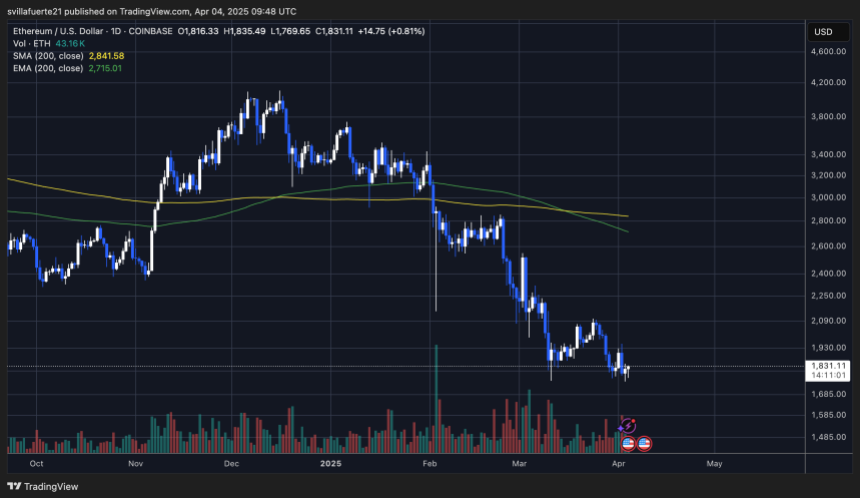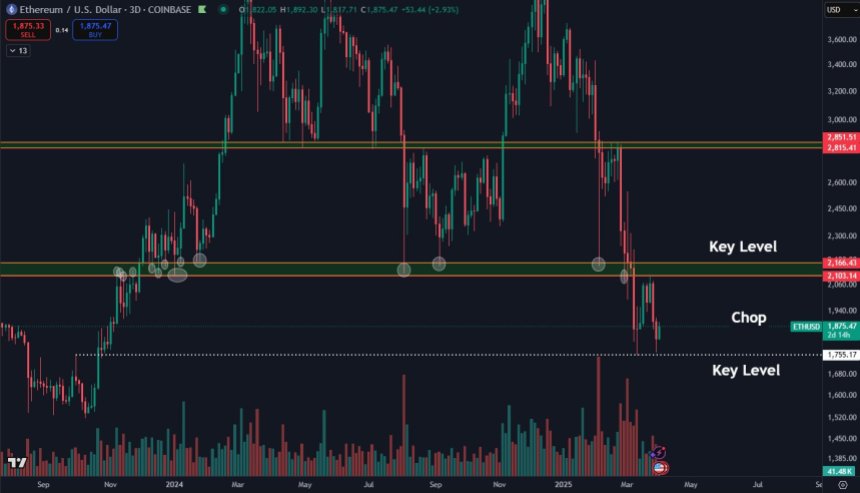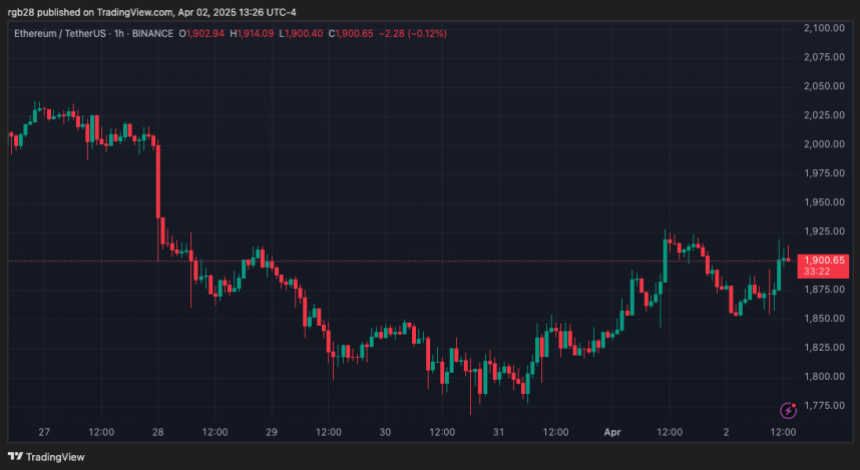Ethereum
Bybit CEO confirms that $280M of the stolen $1.4B is no longer traceable


- Bybit CEO has said that 20% of the $1.4B stolen from the exchange is now untraceable.
- Hackers converted $1B in ETH to BTC via THORChain and spread it.
- So far, 11 bounty hunters have assisted in freezing $42M of the stolen funds.
In a stunning update, Bybit CEO Ben Zhou has revealed that $280 million of the $1.4 billion stolen from the cryptocurrency exchange in the February hack has vanished into untraceable channels.
3.4.25 Executive Summary on Hacked Funds:
Total hacked funds of USD 1.4bn around 500k ETH, 77% are still traceable, 20% has gone dark, 3% have been frozen.
Breakdown:
– 83% (417,348 ETH, ~$1B) have been converted into BTC with 6,954 wallets (Average 1.71 btc each) . This and…— Ben Zhou (@benbybit) March 4, 2025
The security breach, attributed to the North Korean hacking group Lazarus, saw approximately 500,000 Ether (ETH) pilfered from Bybit’s reserves. While the majority of the funds remains visible on the blockchain, Zhou’s announcement underscores the challenges facing investigators as they race against time to freeze the assets before the hackers fully cash out.
The attack exploited vulnerabilities in SafeWallet, a third-party wallet platform used by Bybit. Lazarus hackers compromised a developer’s device, injecting malicious code that allowed them to siphon off nearly $1.5 billion in ETH during a routine transfer.
Despite Bybit’s swift action to restore 1:1 backing of client assets within days, the hackers have been relentlessly moving the stolen funds across multiple platforms, complicating recovery efforts.
Hackers leveraged THORChain to fragment funds
A significant portion of the stolen Ether—417,348 ETH valued at around $1 billion—has been converted into Bitcoin (BTC) and scattered across 6,954 wallets, each holding an average of 1.71 BTC.
Zhou noted that 72% of the haul, or 361,255 ETH worth $900 million, was funneled through THORChain, a decentralized exchange known for its privacy features.
THORChain alone processed a record $4.66 billion in swaps in the week ending March 2, raking in over $5.5 million in fees from these illicit transactions. This fragmentation and conversion strategy has made tracking the funds increasingly difficult for blockchain forensic teams.
Meanwhile, 20% of the stolen assets—approximately 79,655 ETH—have “gone dark,” meaning they’ve been laundered through platforms like ExCH and rendered untraceable.
Zhou highlighted that an additional 40,233 ETH, worth $100 million, passed through OKX’s Web3 Proxy. Of this, 23,553 ETH ($65 million) remains untraceable without further cooperation from the OKX Wallet team, while 16,680 ETH is still within reach of investigators.
The CEO stressed that the next one to two weeks are pivotal as the hackers prepare to offload their haul via exchanges, over-the-counter (OTC) trading desks, and peer-to-peer (P2P) networks.
Bybit has enlisted bounty hunters amid freezing efforts
In a bid to thwart the hackers, Bybit has enlisted the help of bounty hunters and security firms.
Zhou reported that 11 parties—including prominent players like Mantle, Paraswap, and blockchain sleuth ZachXBT—have assisted in freezing $42 million, or 3% of the stolen funds.
So far, Bybit has paid out $2.178 million in USDT to these contributors as part of its recovery efforts, with more details available at Lazarusbounty.com. The exchange also partnered with Web3 security firm ZeroShadow on February 25 to enhance its blockchain forensics and maximize asset recovery.
Despite these efforts, the hackers show no signs of slowing down. Blockchain analytics firm Elliptic has identified over 11,000 wallets linked to the Lazarus group, suggesting a sprawling network designed to obscure their tracks.
🚨 Free Real-time Bybit Exploit Data 🚨
Elliptic has launched a free data feed of illicit addresses linked to the Bybit exploit.
🔍 Why it matters:
✅ Minimize exposure to sanctions
✅ Stop laundering of stolen funds
✅ Strengthen crypto securityAccess via CSV or API ⬇️… pic.twitter.com/U9Qa2tc8Zz
— Elliptic (@elliptic) February 25, 2025
Zhou indicated that an additional $65 million in ETH could be salvaged with OKX’s support, but time is running out as the attackers continue laundering operations through platforms like ExCH and OKX Web3 Proxy.
Ethereum
Ethereum Whales Buy the Dip – Over 130K ETH Added In A Single Day

Reason to trust

Strict editorial policy that focuses on accuracy, relevance, and impartiality
Created by industry experts and meticulously reviewed
The highest standards in reporting and publishing
Strict editorial policy that focuses on accuracy, relevance, and impartiality
Morbi pretium leo et nisl aliquam mollis. Quisque arcu lorem, ultricies quis pellentesque nec, ullamcorper eu odio.
Ethereum is trading below the $1,900 level, facing ongoing selling pressure as the broader crypto market continues to weaken. After a sharp rejection from the $2,500 mark in late February, bulls have failed to regain momentum, and ETH has steadily declined — disappointing many investors who entered the year with high expectations for a bullish trend. The loss of key support levels has further damaged sentiment, and Ethereum’s price action remains bearish in the short term.
Related Reading
Despite the negative outlook, there are signs of accumulation beneath the surface. According to data from IntoTheBlock, Ethereum whales are buying the dip. The largest ETH wallets added over 130,000 ETH to their holdings just yesterday — a move that suggests confidence from long-term players even as retail sentiment wavers.
This accumulation could signal a shift in momentum if sustained, especially if whales continue to absorb supply while prices remain low. However, for any real recovery to take hold, Ethereum must reclaim critical resistance levels and show stronger buying activity across the board. For now, the market remains under pressure, but whale behavior could offer a hint of what’s to come once the current downtrend begins to ease.
Ethereum Big Players Buy Amid Market Uncertainty
Ethereum is currently down 55% from its December high, reflecting the broader pain across the crypto market. The selloff has been fueled in large part by rising macroeconomic uncertainty, with U.S. President Donald Trump’s aggressive trade policies and unpredictable tariff announcements adding to global financial instability. As traditional markets struggle to find footing, high-risk assets like Ethereum have been among the hardest hit.
Bulls are having a difficult time defending key support levels, and price action suggests the downtrend may continue in the short term. With Ethereum trading well below the $1,900 mark and no clear signs of bullish momentum, the outlook remains fragile.
Still, not all signals are bearish. According to data from IntoTheBlock, Ethereum whales appear to be accumulating. On a single day, the largest ETH wallets added over 130,000 ETH to their holdings — a move that suggests quiet confidence among major players. This level of accumulation, especially during periods of fear and weakness, often hints at a long-term bullish outlook.

While price continues to trend lower, the behavior of these large holders adds to the speculative environment, signaling that some investors may be positioning early for a potential surge. If macro conditions begin to stabilize or sentiment shifts, Ethereum could benefit from this quiet accumulation phase — but for now, the market remains in correction mode.
Related Reading
Technical Analysis: ETH Bulls Defend Critical Support
Ethereum is trading at $1,830 following a wave of heavy selling pressure that pushed the price sharply below the key $2,000 level. Panic selling has gripped the market, with bulls struggling to regain control amid a broader downturn across the crypto space. The breakdown below $2,000 marked a significant shift in sentiment, turning what was once viewed as a consolidation phase into a deeper correction.

At this stage, bulls must hold the $1,800 support level — a critical threshold that, if lost, could lead to a further decline toward $1,750 or lower. Holding above $1,800 would allow for stabilization and the chance to build a foundation for recovery. However, to signal a meaningful reversal, Ethereum needs to reclaim the $2,100 level, which now acts as short-term resistance.
Related Reading
Only a decisive push above that mark would confirm renewed strength and potentially reestablish bullish momentum. Until then, ETH remains vulnerable to further downside. With broader market conditions still uncertain, Ethereum’s next move around these support levels will be crucial in determining whether it can recover in the near term or slide deeper into correction territory.
Featured image from Dall-E, chart from TradingView
Ethereum
Ethereum Faces ‘Hyperinflation Hellscape’—Analyst Reveals Key On-Chain Insights

Ethereum (ETH) continues to underperform in the broader cryptocurrency market, currently trading just below $1,800 after falling 4% in the past 24 hours. Despite a strong start to the year, where the crypto market experienced bullish momentum, ETH has failed to sustain its upward trajectory.
Since slipping below the $3,000 level, the asset has largely ranged downward and has now breached the $2,000 support zone, signaling weakening demand and sentiment.
While Bitcoin and other major digital assets still managed to see some recovery efforts in recent weeks, Ethereum’s price decline has been accompanied by decreasing network activity and weakening on-chain fundamentals.
This divergence has raised concerns over ETH’s short-term outlook and prompted a fresh analysis of the underlying causes driving the asset’s performance.
Fee Decline and Network Inactivity Fuel Inflationary Pressures
CryptoQuant analyst EgyHash recently published a report highlighting key on-chain metrics that suggest Ethereum’s current market weakness is closely tied to its declining fee economy and user activity.
According to the report titled: “Why Ethereum Is Bleeding Value: Fee Crash Meets Hyperinflation Hellscape.” Ethereum’s network is experiencing its lowest levels of activity since 2020.

Daily active addresses have declined steadily since early 2025, and average transaction fees have dropped to record lows. This reduction in activity has led to a sharp fall in Ethereum’s burn rate, a metric crucial in offsetting inflationary pressures following the network’s transition to proof-of-stake.
The Dencun upgrade, which was expected to enhance network efficiency, has coincided with an extended period of low transaction volumes, further reducing fee income and contributing to higher net ETH issuance.

EgyHash concludes that the confluence of weak network engagement, reduced burn rate, and high token inflation is central to Ethereum’s declining valuation.
Why Ethereum Is Bleeding Value
“Ethereum’s recent underperformance can be largely attributed to diminished network activity, as evidenced by declining active addresses and reduced transaction fees.” – By @EgyHashX pic.twitter.com/fgQJYCrOIn
— CryptoQuant.com (@cryptoquant_com) April 3, 2025
Ethereum Technical Outlook Signals Potential Support
Despite on-chain headwinds, some technical analysts maintain a cautiously optimistic view. Trader Courage, a technical analyst on X, noted that Ethereum is currently testing a major support zone and could rebound toward the upper resistance of its current trading range.
Back at the green support line. Looks like we could be heading towards the top of the range.
Key levels are on the chart.#Ethereum pic.twitter.com/rRX8b3b6nW
— Trader Courage
(@CryptoCourage1) April 3, 2025
Another market analyst, CryptoElite, shared a long-term ascending trendline that ETH has respected historically. Based on this trend, the analyst believes ETH could still have the potential to rally to $10,000 later in the year, provided broader market conditions improve.
Featured image created with DALL-E, Chart from TradingView
Ethereum
Ethereum Trading In ‘No Man’s Land’, Breakout A ‘Matter Of Time’?

Reason to trust

Strict editorial policy that focuses on accuracy, relevance, and impartiality
Created by industry experts and meticulously reviewed
The highest standards in reporting and publishing
Strict editorial policy that focuses on accuracy, relevance, and impartiality
Morbi pretium leo et nisl aliquam mollis. Quisque arcu lorem, ultricies quis pellentesque nec, ullamcorper eu odio.
Ethereum (ETH) continues failing to reclaim the $2,100 resistance, dropping 6% in the past week. As the second largest crypto trades within its “make or break” levels, some market watchers suggest it will continue to move sideways before another major move.
Related Reading
Ethereum Trades At 2023 Levels
After closing its worst Q1 since 2018, Ethereum continued moving sideways, hovering between the $1,775-$1,925 price range. Amid last Monday’s recovery, Ethereum traded only 6% below its monthly opening, eyeing a potential positive close in the monthly timeframe.
Nonetheless, the cryptocurrency fell over 10% from last week’s high to close the first quarter 45.4% below its January opening and 18.6% from its March opening. Moreover, it registers its worst performance in seven years, recording four consecutive months of bleeding for the first time since 2018.
Daan Crypto Trades noted that ETH is “still trading in no man’s land” despite its recent attempts to break above its current range. In early March, Ethereum dropped below the $2,100 mark, losing its 2024 gains and hitting a 16-month low of $1,750.

The trader suggested that the crucial levels to watch are a breakdown below $1,750 or a breakout above $2,100. “Anything in between is just going to be a painful chop,” he added.
Another market watcher, Merlijn The Trader, highlighted that ETH is at 2021 levels, pointing that it is trading within the breakout zone that led to Ethereum’s all-time high (ATH) but has stronger fundamentals and more institutional demand four years later.
“ETH is sitting on the same monthly support that ignited the 2021 bull run. Hold it, and $10K is in play. Lose it… and things get ugly,” he detailed.
More Chop Before ETH’s Next Move?
Analyst VirtualBacon considers that Ethereum will continue to trade within its current price range for the time being. He explained that ETH’s price has fallen to retest the last bear market resistance levels, as it has erased all its gains since November 2023.
The analyst considers this zone a “good value range” but doesn’t expect the cryptocurrency to break out “right away.” However, he added that a bullish breakout is “simply a matter of time” in longer timeframes.
“Ethereum always catches up when the Fed pivots and the global liquidity index beings to uptrend. That’s when you see the ETH/BTC ratio start to turn up again, leading the rest of the altcoin market,” he concluded.
Related Reading
Ali Martinez pointed out that the number of large ETH transactions has significantly declined in over a month, dropping 63.8% since February 25.
During this period, large transactions fell from 14,500 to 5,190, signaling a drop in whale activity on the network. He also noted that whales have sold 760,000 ETH in the last two weeks.
As of this writing, Ethereum trades at $1,903, a 6% drop in the weekly timeframe.

Featured Image from Unsplash.com, Chart from TradingView.com
-

 Market24 hours ago
Market24 hours agoWormhole (W) Jumps 10%—But Is a Pullback Coming?
-

 Altcoin23 hours ago
Altcoin23 hours agoAltcoin Season Still In Sight Even As Ethereum Struggles To Gain Upward Momentum
-

 Market23 hours ago
Market23 hours agoBinance’s CZ is Helping Kyrgyzstan Become A Crypto Hub
-

 Market21 hours ago
Market21 hours agoCrypto Market Mirrors Nasdaq and S&P 500 Amid Recession Fears
-

 Altcoin21 hours ago
Altcoin21 hours agoExpert Reveals XRP Price Could Drop To $1.90 Before Rally To New Highs
-

 Bitcoin20 hours ago
Bitcoin20 hours agoWhy ETF Issuers are Buying Bitcoin Despite Recession Fears
-

 Ethereum18 hours ago
Ethereum18 hours agoEthereum Faces ‘Hyperinflation Hellscape’—Analyst Reveals Key On-Chain Insights
-

 Market17 hours ago
Market17 hours agoWhat to Expect After March’s Struggles
























